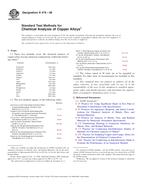1.1 These test methods cover the chemical analysis of copper alloys having chemical compositions within the following limits:
| Element | Concentration, % |
| Aluminum | 12.0 max |
| Antimony | 1.0 max |
| Arsenic | 1.0 max |
| Cadmium | 1.5 max |
| Cobalt | 1.0 max |
| Copper | 40.0 min |
| Iron | 6.0 max |
| Lead | 27.0 max |
| Manganese | 6.0 max |
| Nickel | 50.0 max |
| Phosphorus | 1.0 max |
| Silicon | 5.0 max |
| Sulfur | 0.1 max |
| Tin | 20.0 max |
| Zinc | 50.0 max |
1.2 The test methods appear in the following order:
| Sections | |
| Aluminum by the Carbamate Extraction-Ethyl- enedinitrilotetraacetate Titrimetric Test Method [2 % to 12 %] |
71-78 |
| Copper by the Combined Electrodeposition Gravimetric and Oxalyldihydrazide Photometric Test Method [50 %, minimum] | 10-18 |
| Iron by the 1,10-Phenanthroline Photometric Test Method [0.003 % to 1.25 %] | 19-28 |
| Lead by Atomic Absorption Spectrometry [0.002 % to 15 %] | 90-100 |
| Lead by the Ethylenedinitrilotetraacetic Acid (EDTA) Titrimetric Test Method [2.0 % to 30.0 %] | 29-36 |
| Nickel by the Dimethylglyoxime Extraction Photometric Test Method [0.03 % to 5.0 %] | 37-46 |
| Nickel by the Dimethylglyoxime Gravimetric Test Method [4 % to 50 %] | 55-62 |
| Silver in Silver-Bearing Copper by Atomic Absorption Spectrometry [0.01 % to 0.12 %] | 101-112 |
| Tin by the Iodotimetric Titration Test Method [0.5 % to 20 %] | 63-70 |
| Tin by the Phenylfluorone Photometric Test Method [0.01 % to 1.0 %] | 113-123 |
| Zinc by Atomic Absorption Spectrometry [0.2 % to 2 %] | 79-89 |
| Zinc by the Ethylenedinitrilotetraacetic Acid (EDTA) Titrimetric Test Method [2 % to 40 %] | 47-54 |
1.3 The values stated in SI units are to be regarded as standard. No other units of measurement are included in this standard.
1.4 This standard does not purport to address all of the safety concerns, if any, associated with its use. It is the responsibility of the user of this standard to establish appropriate safety and health practices and determine the applicability of regulatory limitations prior to use.
10.1 This test method covers the determination of copper in concentrations greater than 50 %.
19.1 This test method covers the determination of iron in concentrations from 0.003 % to 1.25 %.
29.1 This test method covers the determination of lead in concentrations from 2.0 % to 30.0 %.
37.1 This test method covers the determination of nickel in concentrations from 0.03 % to 5.0 %.
47.1 This test method covers the determination of zinc in the range from 2 % to 40 %.
55.1 This test method covers the determination of nickel in concentrations from 4 % to 50 %.
63.1 This test method covers the determination of tin in concentrations from 0.5 % to 20 %.
71.1 This test method covers the determination of aluminum in concentrations from 2 % to 12 %.
79.1 This test method covers the determination of zinc in concentrations from 0.02 % to 2 %.
90.1 This test method covers the determination of lead in concentrations from 0.002 % to 15 %.
101.1 This test method covers the determination of silver in concentrations from 0.01 % to 0.12 %.
113.1 This test method covers the determination of tin in concentrations from 0.01 % to 1.0 %.
Product Details
- Published:
- 12/15/2008
- Number of Pages:
- 21
- File Size:
- 1 file , 260 KB
- Redline File Size:
- 2 files , 490 KB
